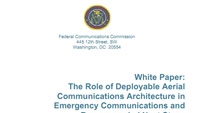FCC white paper explores deployable emergency communications system

A new white paper from an FCC bureau outlines how to restore communications to first responders by using an airborne communications infrastructure in the wake of a catastrophic event.
The paper, produced by the Federal Communications Commission’s Public Safety and Homeland Security Bureau, examines how “deployable aerial communications architecture” (DACA) could provide communications in the event a catastrophic event renders the terrestrial communications infrastructure incapacitated.
"We are reminded daily that a catastrophic disaster, natural or otherwise, can occur anytime and anywhere,” said James Barnett Jr., Rear Admiral (ret.), Chief of the FCC's Public Safety and Homeland Security Bureau. “Terrestrial communications services are often severely impaired — or knocked out entirely — during these events, which complicates even the most prepared response effort.”
The white paper, “The Role of Deployable Aerial Communications Architecture in Emergency Communications and Recommended Next Steps,” analyzes how DACA could help restore emergency communications 12 to 18 hours after an event occurs.
The bureau has recommended several actions based on the white paper, including:
- Open an inquiry by the end of the year on a variety of DACA related issues, such as cost, radio interference, spectrum coordination and operational procedures
- Host a DACA workshop before the end of the year
- Share findings with other pertinent government agencies
- Explore any international implications
The professional video industry's #1 source for news, trends and product and tech information. Sign up below.
